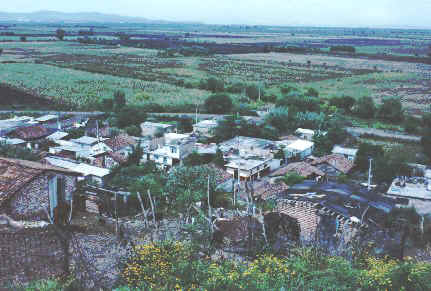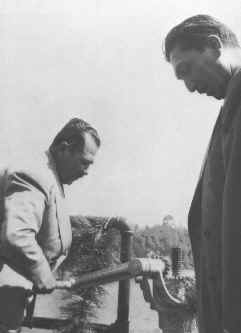 The community of Cerrito Cotijaran, 1991. Most of its people live from their earnings as field hands in the United States.
The community of Cerrito Cotijaran, 1991. Most of its people live from their earnings as field hands in the United States. The community of Cerrito Cotijaran, 1991. Most of its people live from their earnings as field hands in the United States.
The community of Cerrito Cotijaran, 1991. Most of its people live from their earnings as field hands in the United States.
If the more arcadian landscape of the past had disguised the fact that the peasants themselves were not really the main beneficiaries of the process of "development," the landscape of the Nineties poses the starker question of whether Mexican agriculture as a whole can recover from the damage wrought by a now discredited Salinismo. It is not, however, simply a product of the economic policy mistakes of Salinismo, which remained uncorrected by the succeeding administration of Ernesto Zedillo, which was even less preoccupied with the problems of reviving agricultural production as it confronted the generalized economic and political crisis which developed after the financial crash of December 1994 and the political crisis which engulfed the country and ruling PRI.
As an especially favoured child of Cardenismo, the Ciénega de Chapala illustrates the limitations of even the most apparently radical moment of agrarian reform in Mexico, limitations which are at once political in origin and also related to the predominantly capitalist character of the national economy. During the 1970s, the region illustrated the limitations of the neo-populist statism that preceded neoliberalism: if, with hindsight, the period between 1970 and 1982 might be seen as virtually a "Golden Age" from the campesino (peasant) perspective in comparison with the periods which preceded and followed it, this was also a period during which the capitalist transformation of rural society deepened in significant respects, and in which the international dimensions of that transformation became more visible. From the ecological standpoint, it was also a period which was destructive of the region’s capacity to reproduce its former richness and diversity. The progressive erosion of the material foundations of a regional agricultural society had been preceded by social changes which undermined some of the bases for community and peasant cooperation, and the increasing dependence of campesino households on migrant labour north of the border has reinforced these tendencies, especially in recent years.
Cartoon of ex-President Salinas
The Ciénega de Chapala could be seen as a region caught up in two, interrelated, processes. One is the unfolding and unravelling of a land reform project inextricably linked to the political project of maintaining the hegemony of the party of the state created to consolidate the power of the urban caudillos who defeated the popular peasant project embedded in the Mexican Revolution. The other is the evolution of a set of transnational class relations based on the articulation of this zone of rural Mexico with centres of economic power in the United States via flows of migrant labour power and commodities. This second process suggests the need for a more critical look at the arguments of neoliberal "reformers" that the Mexican ejido has failed in regions like the Ciénega de Chapala. What, from the Mexican side of the border, looks like decapitalization and a failure to sustain social reproduction might be viewed in a more positive light by Mexico’s northern neighbour. U.S. capital has secured both the benefits of employing workers from households which are partly sustained by economic activities in the South and markets for a variety of products, including the farm machinery, chemical herbicides and pesticides which underpinned the transformation of Ciénega agriculture (and the local ecosystem) in the 1970s.
 Ex-President Cárdenas promoting new irrigation systems in the Tierra Caliente in the 1960s as President of the Tepalcatepec River Basin Development Commission
Ex-President Cárdenas promoting new irrigation systems in the Tierra Caliente in the 1960s as President of the Tepalcatepec River Basin Development Commission